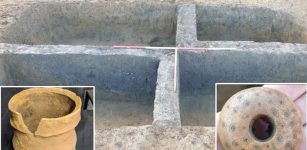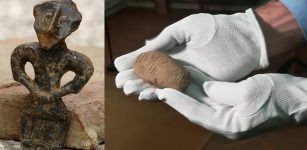Rare 7,000-Year-Old Clay Figurine Discovered In Battifratta Cave, Lazio
Jan Bartek - AncientPages.com - Scientists found a curious ancient artifact while excavating in a cave in Poggio Nativo, Lazio, Italy. The object in question has been described as a rare, 7,000-year-old clay figurine made in an unknown individual's image. Who does the ancient figurine depict? Could it be an unknown ancient goddess, a woman we have heard nothing about, or was this artifact a toy, perhaps a child's precious little doll?
This ancient clay figurine may have been a goddess, an unknown woman, or a doll. Credit: Sapienza University of Rome
Scientists have been investigating the cave of Battifratta since 2021. Still, this particular clay figurine is considered unique because artifacts of this type from the Neolithic period, when the first farming communities inhabited the peninsula, are "almost absent in the Tyrrhenian regions".
Situated by a seasonal spring, the Battifratta cave was important to ancient people who sought shelter and water there. The cave in Poggio Nativo has long intrigued archaeologists who now consider the place may have been of ritualistic importance in the past.
During previous excavations conducted in the Battifratta cave, archaeologists have found a number of objects and even a human skeleton suggesting the place was used for burial and ritual purposes.
The ancient artifact is currently being examined by experts who will look closer at stylistic aspects in order to find out how the artifact was made and whether it reflects iconographic models that can be traced back to distinct cultural traditions.
Battifratta cave, where the Neolithic clay figurine was unearthed. Credit: Sapienza University of Rome
The Sapienza University of Rome explains in a press statement that though the clay figurine is quite simple, its facial features are “outlined schematically”. The creator of the artifact appears to have focused attention on the figure's hairstyle and body decorations.
“The presence of pottery, lithic industry, faunal and botanical artifacts on several stratified levels reveals the use of the spring and the cave not only for water supply but also for burial and ritual purposes, as evidenced by the human skeletal remains found and the clay figurine,” Cecilia Conati, a Classics professor at Sapienza University, explained in the statement.
See also: More Archaeology News
Clay figurines were common in the past, but this particular find will according to the Sapienza University of Rome, will add much new information about the importance of the Battifratta cave, as well as the prehistory of Lazio and central Italy.
Written by Jan Bartek – AncientPages.com Staff






















